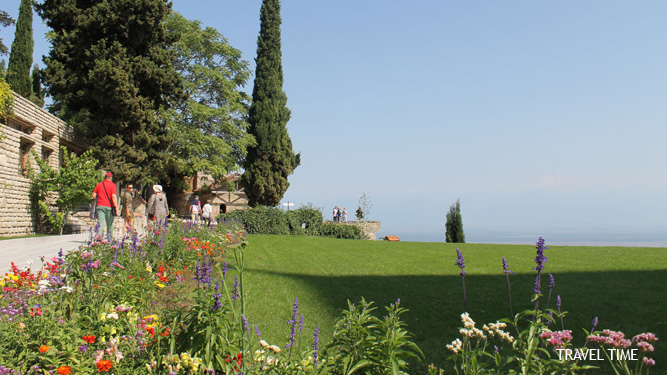
Day Trips from Tbilisi
Day trip to kazbegi

If you only have time for one day trip from Tbilisi, we recommend go to Kazbegi .
Distance from Tbilisi to Kazbegi | 153km.
Travel time | Approx. 2.5 hours
The area not only takes in the amazing Kazbegi region, home to glaciers, gorges and the 5,047 meter Mount Kazbegi,Georgia’s most developed skiing resort at Gudauri. Best of all, the whole province is just a short drive away from Tbilisi. There’s plenty to do in kazbegi, from absorbing the culture to creating your own exhilarating adventures.
Day trip to Mtskheta

Travel time | Approx. 40 minutes
Mtskheta, a UNESCO World Heritage Site, has been inhabited since before 1,000 BC and was once the capital of the early kingdom of Iberia, (today’s Eastern Georgia). Just 20km from today’s capital Tbilisi, and situated at the confluence of the Mtkvari and Aragvi rivers, the city is located on an ancient trade route. Archaeologists have unearthed the evidence of Mtskheta’s status as a major trading post.
Mtskheta Cross Monastery (Jvari)
Jvari is one of the masterpieces of Georgian architecture and is now listed as one of the World Heritage sites by UNESCO. It was built on a hill near Mtskheta overlooking the estuary of two rivers, the Mtkvari and Aragvi. However the original structure was much smaller. After converting to Christianity, King Mirian erected a tall wooden cross on the hill, which was venerated by various Christian nations. Later a smaller church was built beside the church and is now referred to as the Small Cross. However, the church was too small to hold all the visitors and in 586 – 604 AD the larger Jvari cathedral was built over the wooden cross. The pedestal of the old cross has been preserved. Although there are many religious buildings in and outside Georgia with similar architecture you won’t find any that are older and more complete than Mtskheta Cross.
Svetitskhoveli Cathedral
Located in Mtskheta, Svetitskhoveli Cathedral has been the burial site for Georgian kings and is built on the site where it is said that the robe of Jesus is buried. In 337 AD, when Georgia announced Christianity as its official religion, the first Christian King Mirian was advised by St. Nino, to build a church here, over the grave where Christ’s robe was buried (having been brought back to Georgia by a Georgian Jew, who had bought it off from a Roman soldier at Golgotha). A Lebanese cedar tree growing on the grave was cut down and used to make seven pillars to build the church. However, the seventh and biggest pillar had magical properties which meant that it was hung in the air unsupported, until St. Nino prayed for it to return to earth. This pillar was said to have illuminated light and radiated a lovely fragrance and even a miraculous chrism which could cure many diseases. The pillar was called “Sveti Tskhoveli” – a life-giving pillar – which later became the name also given to the Cathedral. An icon portraying this event can be seen on the second column on the right-hand from the entrance.
Day trip to Kakheti



Distance from Tbilisi to Telavi | 94km
Distance from Telavi to Yvareli | 41km
Distance from Yvareli to sihgnahgi | 60km
Travel time | Approx. 3.0 hours
Telavi
Telavi is home of several of the region’s world-famous wineries, art museums, castles, and a theatre highlighting folk singing and dancing. Telavi is located on the crossroad of the region and is an ideal place to stop for a lunch or an excellent jumping-off point for two or three-day-excursions.
Tsinandali Museum
Built in the early 19th century by the Chavchavadze family, the Tsinandali estate is encircled by well-maintained gardens and rare trees not found elsewhere in Georgia. The house itself has been converted into a museum honouring the poet Alexander Chavchavadze, leader of Georgian romanticism. Behind the museum, there is the famous Tsinandali wine cellar . You can taste wine on the ground floor of the Chavchavadze Palace.
Yvarel
Yvareli is a quaint town situated in the middle of the Alazani River Plain and is famous as the home of renowned Georgian writer Ilia Chavchavadze. Yvareli is famous for the delicious, semi-sweet Kindzmarauli-wine. Just a short drive away is a magnificent Ilia lake which is well worth a visit.
Sighnaghi
The name of the town comes from Turkish word “Signak” meaning a shelter and has had a rich history as a centre for tradesmen and artisans. The winding cobblestone streets, Italian architecture, and 18th century defensive walls create a charming atmosphere. Down the hill from the main town there are several historic churches. Stay the night and enjoy the hospitality of the innkeepers and restaurateurs.
Sighnaghi Museum
Sighnaghi museum displays many archaeological, ethnographical, and medieval exhibits and artefacts including musical instruments, weapons, clothes, and many other historical items of everyday life. The most remarkable exhibition presents the paintings of Niko Pirosmanashvili, the greatest Georgian self-taught artist of the 19th century.
Day trip to Borjomi Akhaltsikhe

Distance from Tbilisi to Borjomi | 162km
Distance from Borjomi to Akhaltsikhe | 48km
Travel time | Approx. 3.5 hours
Borjomi-Kharagauli National Park
The Borjomi-Kharagauli National Park is one of the largest in Europe and covers more than 76,000 hectares of native forest and sub-alpine and alpine meadows. It is the first National Park in the Caucasus to meet international standards and officially opened in 2001. The flora and fauna found here is very diverse. Rare and endemic species listed in Georgia’s Red Data Book (a list of endangered and protected species) can be found including a wonderful array of mammals. Among large carnivores it is possible to find gray wolves, lynx, and brown bears while roe deer and wild boar can frequently be seen. Among its native birds, the bird enthusiasts will easily spot rare species such as the golden eagle, griffon vulture, black vulture and the Caucasian black grouse.
Akhaltsikhe-Fortress
18th century Akhaltsikhe Fortress is often called the symbol of tolerance, occupies around 7 hectares and was returned to its original appearance. A church, mosque, minaret, synagogue, as well as Jaqelebi Palace, a historic museum, old baths and a citadel, have been restored on the territory of Rabat Castle.




